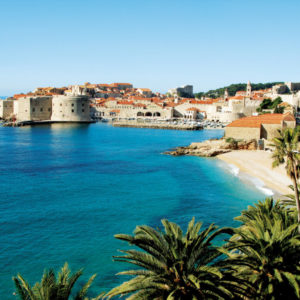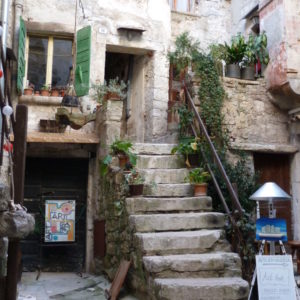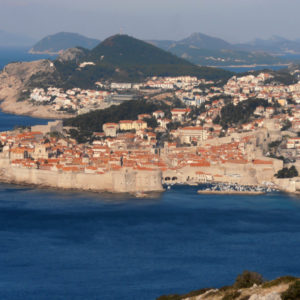Video courtesy of Croatia National Tourist Board
Croatia is a Central European and Mediterranean country, bordering Slovenia in the west, Hungary in the north, Serbia in the east and Bosnia and Herzegovina in the south; the country also has a long maritime border with Italy in the Adriatic Sea. Croatia has an unusual shape (similar to a croissant) that is unlike any other country in the world, which comes as a result of five centuries of expansion by the Ottoman (Turkish) empire towards Central Europe (although Croatia was never conquered by the Turks).
Almost 90% of the population is Croat (the majority of whom are Roman Catholics), but there are also Serbian, Bosnian, Hungarian and Italian minorities. The main population centres are Zagreb, the capital, Osijek in the northeast, and the ports of Rijeka on the northern part of the coastline, and Split towards the south. Other well-known towns include Dubrovnik, Makarska, Porec, Rovinj, Opatija, Zadar and Sibenik.
Croatia has an amazing coastline with islands, cliffs and reefs. There are 1,185 islands in the Adriatic, but only about 50 are populated. The largest island is Krk (near Rijeka), whilst the country’s other well-known islands include Hvar, Brac, Korcula and Pag.
- City of Zagreb
- Istria
- Kvarner
- Dalmatia - Dubrovnik
- Dalmatia - Split
- Lika - Karlovac
- Dalmatia - Zadar
- Dalmatia - Šibenik
- Slavonia
- Central Croatia
- Climate
Come and visit Croatia’s political, commercial and cultural heart! Zagreb’s old town is a true feast for your senses, where you can sample some of the country’s most renowned restaurants and coffee shops in the midst of classic façades, lush gardens and striking Neo-Gothic buildings.
Coastal villages such as Rovinj, with its simple ports, fishing boats and narrow streets, reflect the spirit of the Mediterranean, and the Church of St. Euphemia is ranked among the most beautiful representations of the Baroque period in Istria, while moving inland gives way to the kind of green and fertile hues associated with the landscapes of Provence and Tuscany.
Other wonderful highlights – Pula Amphitheatre and Brijuni National Park, Labin – a Medieval Town, Hum– The Smallest Town in the World, Grožnjan and Motovun – Small, Medieval Istrian Towns, Basilica of St. Euphrasius in Poreč..
Your dream holidays begin in Kvarner, a popular tourist resort with a 150-year history. Wind your way between sunny islands or visit Opatija, with its leafy parks and long seafront promenade.
The landscape soon shifts entirely upon arriving in the wooded and mountainous region of Gorski Kotar. The lungs of Croatia, this area is home to eagles, wolves and bears, as well as the kind of pure air that appeals to hikers and cyclists all over the world. Dare to join them!
Other wonderful highlights – Opatija Riviera and Učka Nature Park, Osor, Lubenice, The Island of Košljun, Town of Rab and Paradise Beach in Lopar and Sanctuary of Our Lady of Trsat and the City of Rijeka.
“The Pearl of the Adriatic” has captivated and seduced kings and artists for centuries with its immaculate medieval architecture. How will it inspire you?
Other wonderful Highlights – Cavtat – The Old Town Core, Dubrovnik – The Old Town Core, Mljet National Park, Korčula – The Town of Marco Polo, The Town Walls of Ston and Narona Archeological Museum.
Follow in his footsteps by exploring Diocletian’s Palace and a region home to islands, stunning natural landscapes such as Biokovo Mountain and Zlatni Rat beach on the island of Brač, and a wealth of culture that will defy your expectations.
Other wonderful Highlights – Sanctuary of Our Lady of Sinj, Biokovo Nature Park, Stari Grad Plain and the Town of Hvar, River Cetina, Diocletian’s Palace in Split and the Ancient Town of Salona in Solin and Trogir – Romanesque Town Centre.
The most iconic of all is Plitvice Lakes National Park, that captivates visitors with its wild beauty, 16 shimmering lakes and 129 bird species, placing it firmly on the must-see list for any nature enthusiast.
Other wonderful Highlights – Rastoke – Millers’ Village, “Nikola Tesla” Memorial Centre, Smiljan, Velebit Nature Park and North Velebit National Park, Medieval town of Ogulin and The Star of Karlovac – The Renaissance Core of the Town of Karlovac.
It is only in this part of land that you will peek into the world’s smallest cathedral –the Church of the Holy Cross, in the city of Nin–, before touring the largest Roman forum on these shores of the Adriatic.
And if that were not enough, you will discover the origins of Croatia’s cultural identity in the city of Zadar, with over 3,000 years of history.
Other wonderful Highlights – Pag–salt Pans, Nin Cathedral, Vrana Lake, Telašćica Nature Park, Paklenica National Park and Church of St. Donatus, Zadar.
The unspoilt landscapes of the Kornati archipelago or the mind-blowing waterfalls and lakes of Krka are both designated national parks and only two of the unmissable stops on your island-hopping route.
Other wonderful Highlights – Skradin, Krapanj – Brodarica, Kornati National Park, St Jacob’s Cathedral in Šibenik, Krka National Park and Knin Fortress on Mount Spas.
They are also generous hosts, always ready to engage in a heart-to-heart over a glass of one of the many quality wines produced by the area’s fertile lowlands and some of the spicy local dishes such as čobanac (stew) or fiš paprikaš (fish soup).
A mere stone’s throw to the north and northeast of capital Zagreb, the region is dotted with romantic medieval towns such as Koprivnica or Varaždin, countryside manors such as Trakošćan Castle and thermal spas perfect for restoring your energies, leaving you revitalised and full of life.
Showing all 3 results
-
 Croatia, Europe & Russia, Hot Destinations
Croatia, Europe & Russia, Hot DestinationsFamily Active Holiday on the Dalmatian Coast and Islands – 10 days
Read more Croatia, Europe & Russia, Hot Destinations, Montenegro, Slovenia
Croatia, Europe & Russia, Hot Destinations, Montenegro, SloveniaHighlights of CROATIA, MONTENEGRO & SLOVENIA – 14 Days
Read moreNeed Assistance?
800-227-5317 | sales@pacific-destinations.com
Tell us where and when you want to go and we’ll give your request our immediate attention! No high pressure sales, just straight talk and sound advice!

